| Overview |
Task templates provide you with the ability to define common tasks for objects (such as Projects, Quality/CAPA processes, and Change/ECO tasks).
Task templates can be applied/appended to objects using "Paste" operations.
Task templates are created using Omnify Desktop and managed/modified in the Omnify Administrator.
To manage/modify task templates, select the Task Templates option from the Navigation tree.

|
 |
Creating Templates |
Top |
|
Task templates are created on the Tasks tab/page of the Project, Change/ECO, Quality/CAPA, or Training forms in Omnify Desktop.

From the Tasks page you can create a list of tasks (refer to the Desktop User's Guide for more information on editing tasks)
and then click the Save/Copy toolbar button.

From the Actions drop list, select the Save as template option.

You can then specify a name for the template and click the Save/Copy button to create the template.

Note: Task templates will be "object specific" (i.e. Project-based task templates will only be available to other Projects).
However, you can copy/create "generic" templates in the Omnify Administrator that will be available to all objects.
|
 |
Using/Applying |
Top |
|
Once a task template has been created, you can assign/append it to any existing object's task page by clicking the Paste toolbar button.
This will present the Paste Tasks dialog box.
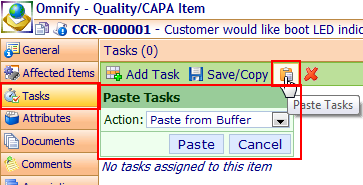
From the Action drop list, select the Paste from Template option.
This will present a list of available task templates.

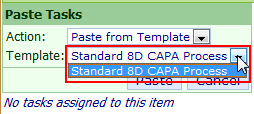
Note: Task templates will be "object specific" (i.e. Project-based task templates will only be available to other Projects).
However, you can copy/create "generic" templates in the Omnify Administrator that will be available to all objects.
To assign the template, select the desired task template from the Template drop list and then click the Paste button.
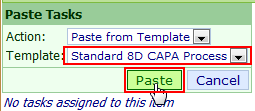
The template tasks will be appended to the existing task list.
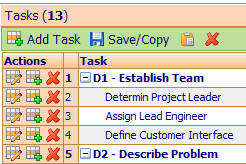
|
 |
Adding/Inserting Tasks |
Top |
|
To modify task templates, select the task template from the Templates drop list.

The page will display the template's object type.

To add a task, select the Add Task toolbar button.
This will present the Add Task dialog box.
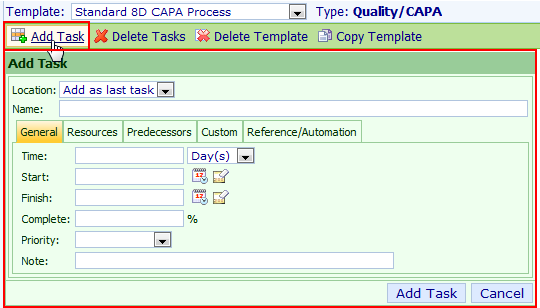
Using the Add Task toolbar button will automatically set the Location field to Add as last task.

From the Add Task dialog you can specify the Name of the new task.
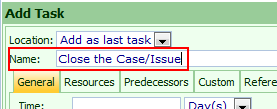
The General tab allows you to set the start date and duration of the task, as well as the percent complete and priority.

Selecting the Resources tab allows you to assign users and/or project roles.

Selecting the Predecessors tab allows you to assign predecessor tasks.
Predecessor tasks are tasks in which other tasks rely on to determine their Start date.
Tasks that are assigned predecessor tasks will base their start date on the end date of the processor task.

Selecting the Custom tab allows you to assign any custom task fields (defined in the Administrator).

Selecting the Reference/Automation tab allows you to assign objects and define the task to be an "automated" task.

Reference Items will be Omnify objects that will be associated with a specific task.
Reference items will appear as a hyperlink on the task to allow the user to quickly access the item from the task.
Automated Tasks are tasks that can have their status (% Complete) updated automatically based on Omnify or external system actions. For example, the release of a Change/ECO can automatically update set a Task on a Project to 100%.
Once all task properties have been defined, click the Add Task button to add the task.
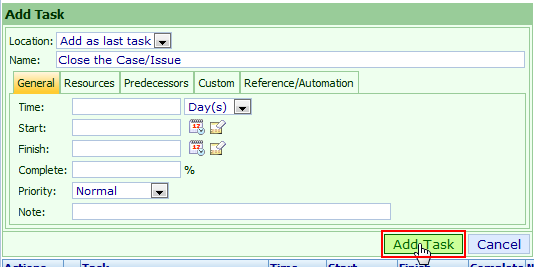
To insert a task before or after another task, or to add a task as a child task of another task, click the Add button in the actions column.
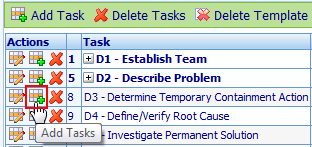
The Add Task dialog box will appear and the Location drop list will then contain the following options:
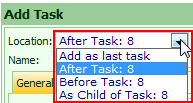
| Add as last task |
Adds task as the last task in list |
| After Task: N |
Adds the task after the selected task.
Note: N represents the task index number that the new task will appear after.
|
| Before Task: N |
Adds the task before the selected task.
Note: N represents the task index number that the new task will appear before.
|
| As Child of Task: N |
Adds the task as a child (indented) task of the selected task.
Note: N represents the task index number that the new task will be a child of.
|
|
 |
Editing Tasks |
Top |
|
To modify task templates, select the task template from the Templates drop list.

To edit an existing task, select the Edit icon in the Actions column for the desired task.
This will present the Edit Task dialog box.
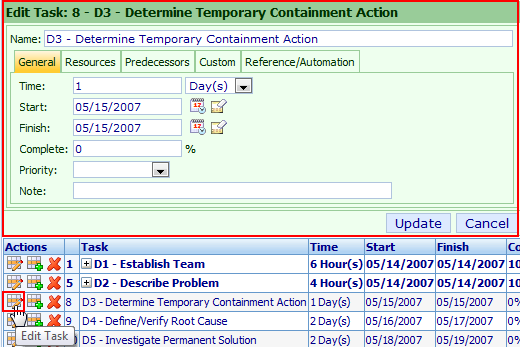
From the dialog box, you can modify any of the task properties and then click the Update button to apply the changes.
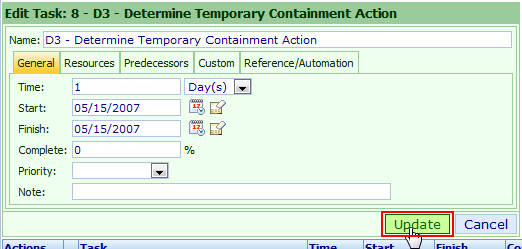
|
 |
Removing Tasks |
Top |
|
To modify task templates, select the task template from the Templates drop list.

To remove an existing task, select the Delete Tasks icon in the Actions column for the desired task.
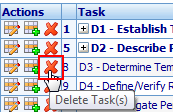
You will be asked to verify the task removal.
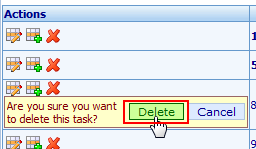
To remove all tasks, click the Remove Tasks toolbar button.

You will be asked to verify the task removal.

|
 |
Deleting Templates |
Top |
|
To delete a task template, select the task template from the Templates drop list.

To remove the template, click the Delete Template toolbar button.
You will be asked to verify the template removal.

|
 |
Copying Templates |
Top |
|
To copy a task template, select the task template from the Templates drop list.

To copy the template, click the Copy Template toolbar button.
This will present the Copy Template dialog box.
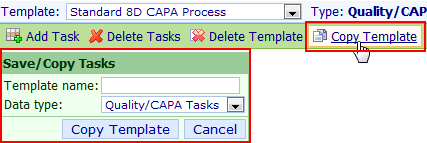
From the Copy Template dialog box, specify a new template name, and the object type.
Note: setting the type to Generic will make the template available to all objects/forms.
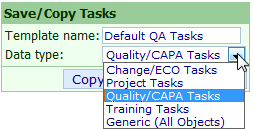
|